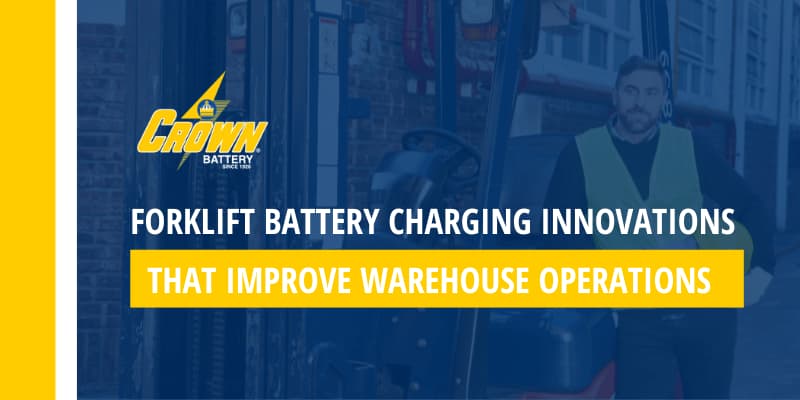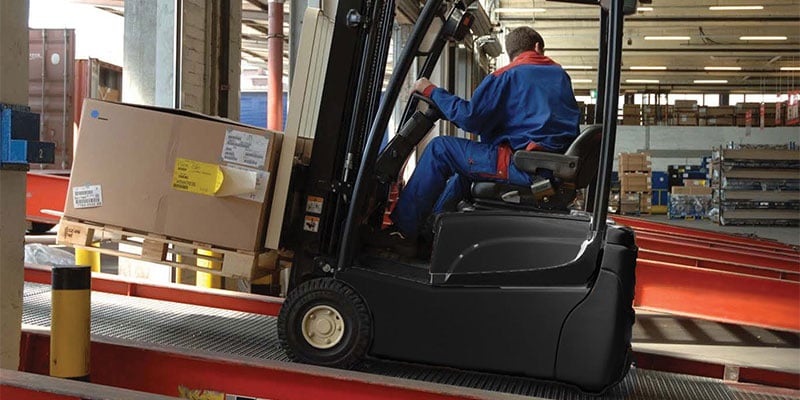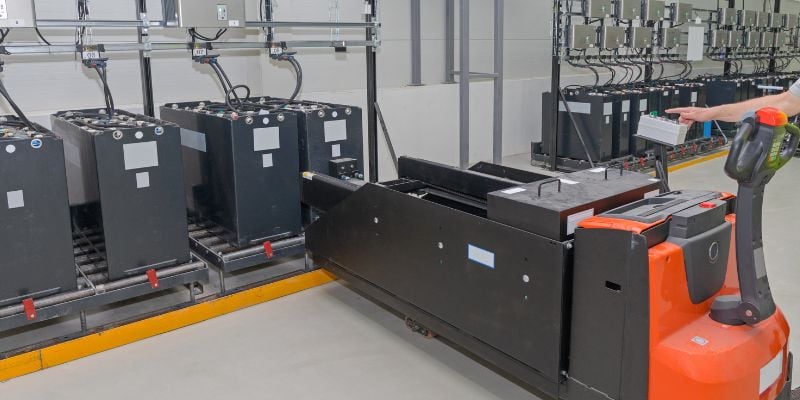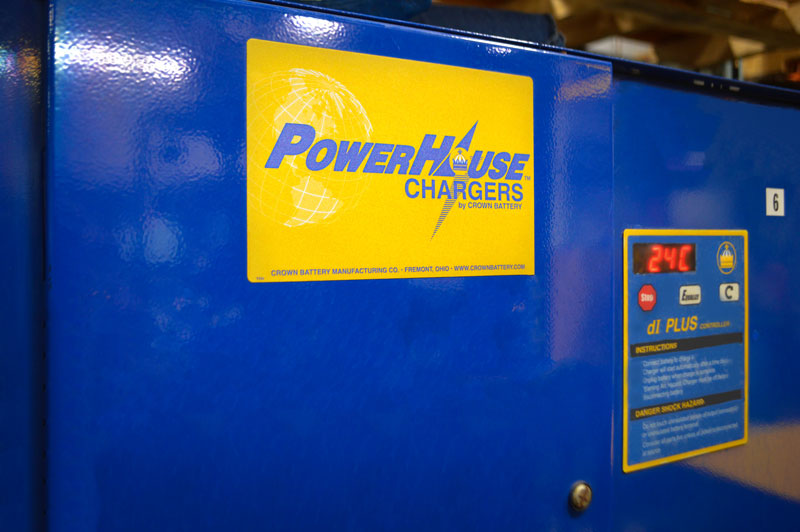Crown’s advanced charging features ensure maximum battery efficiency and ROI… and minimum downtime.
PROBLEM: Conventional battery chargers keep putting energy into a battery after it’s full, creating waste heat that hurts batteries and your profits.
And most traditional chargers are a poor fit for opportunity charging because they charge slower and don’t monitor battery health and capacity.
But which forklift chargers keep up with new workplace trends – and protect your equipment and bottom line?
SOLUTION: Smarter, more sustainable charging from Crown Battery
Crown’s engineers analyzed over 100 applications—from Fortune 500 warehouses to small business forklifts—and they’re breaking down which battery chargers best streamline operations and enhance operational efficiency, uptime, and safety.
The latest innovations in forklift battery charging improve equipment longevity and uptime, reduce your operating costs and maintenance, and arm you with battery and equipment usage data – to make smarter business decisions about upkeep and forecasting. That’s a significant competitive advantage.
Keep reading to discover:
- 3 types of battery chargers – and which one has the latest features and benefits
- Which features reduce energy consumption
- How to speed up charging
- Which technologies uncover charging and battery problems early – to avoid costly early replacement and downtime
- How the Internet of Things (IoT) and data logging help improve usage, efficiency, and decision-making
- Strategies that ensure proper charging every time
COMPARING BATTERY CHARGERS
The basics are confirming that a charger’s Ampere-hour (Ah) rating and output voltage fit your battery; your battery distributor or one of Crown’s energy specialists can help.
Your operating environment, charging location, and available charging time all help determine which charger is right for you.
Each type of battery charger has benefits and drawbacks:
- Conventional ferroresonant chargers feature the lowest startup costs, as well as durability and minimal maintenance. But, their inability to monitor or regulate charge levels based on battery conditions can lead to overcharging. Excess charging may cause overheating, reducing their performance and lifespan – and wasting electricity. Thus, Ferroresonant chargers often cost more than advanced chargers over time.
- Silicon-controlled rectifier (SCR) chargers are recognized for their versatility in handling multiple voltages and their cost-efficiency. They’re often paired with FLA and AGM battery types. However, they’re slower charging and less efficient than smart chargers.
- Smart (“opportunity”) and High-Frequency chargers monitor batteries’ vitals. Onboard computers measure State of Charge (SOC), air and battery temperature, charge rates, and additional variables.
Traditional chargers have a lower up-front cost… but can cost more to operate. By comparison, smart chargers often pay for themselves – and then some – giving them a lower total cost of ownership (TCO).
Modern chargers offer money-saving features and prevent overheating, which otherwise wastes electricity and shortens battery life. Smart and HF chargers also charge faster and ensure full capacity (because of charge adjustments). Because they deliver a positive ROI in just a few years, smart chargers are the most economical way to protect your investment and operations.
Reduce your Electric Bill with Adaptive (Computer-Adjusted) Charging and other Energy-Efficient Features
Conventional chargers use the same charging curve regardless of a battery's temperature, capacity, or other conditions.
By contrast, today’s smart chargers include features such as temperature compensation to modulate charging and avoid damaging batteries by overheating.
And because smart chargers turn less electrical energy into heat, they deliver more power to the battery – with less waste. For example, Crown’s PowerHouse IHF chargers are up to 96% efficient, so nearly all the electricity you pay for goes into your batteries. This lowers your mains power requirements and decreases hardware, installation, and operating costs.
Smart charging also reduces carbon emissions. And it helps protect you from rising energy costs.
Faster Charging Improves Operational Efficiency
Decades ago, foreclosures required hours of downtime to recharge batteries – or hot-swapping (lifting discharged batteries out of forklifts and replacing them with fully charged batteries).
Today, modern chargers like Crown’s PowerHouse IHF provide faster charging because of their hardware and software, ensuring you can run your operations reliably with fewer batteries and less overhead.
Variably Programmable Charging Curves = Charge more Batteries
Conventional battery chargers are often designed for a narrow range of operating parameters.
But smart chargers like the PowerHouse IHF can pulse charge (which knocks off sulfation and can enhance battery life), and you can adjust charging parameters (including voltage and current over time). That way, your charger will be ready for different battery types. And our proprietary Multi-voltage feature even allows you to charge different battery types using the same charging unit.
Spot Problems Sooner with Battery Management Systems (BMS)
BMS lets you “see inside” your battery banks – and helps enhance longevity, reliability, safety, and performance.
A Battery Management System’s specialized computer connects to a network of sensors to give you real-time battery performance and health information, plus optional data collection.
Here’s how it works: BMS constantly analyzes battery measurements and then quickly adjusts charging/discharging parameters. Its sensors can monitor State of Charge (SOC, how much energy is in a battery), State of Health (SOH), battery and cell voltage, internal and external temperature, and more. Some units even estimate charging time.
BMS benefits include:
- Helps protect batteries from common types of damage
- Reduces maintenance and provides early warning
- Shares data that optimizes charging
- Prevents or minimizes overcharging/overheating, short-circuiting, and over-discharging
- Can prolong battery life and improve capacity
These benefits make BMS systems popular for high-stakes operations including power utilities, telecom, data centers, hospitals, off-grid buildings, and material handling applications. (Note: BMS is often beneficial for flooded lead-acid and AGM batteries. And BMS is a safety requirement for lithium-ion batteries to minimize fire and explosion risks; Li-ion’s higher power density makes it vulnerable to thermal runaway and combustion, which BMS can help mitigate.)
Internet of Things (IoT) Data Logging helps Predict Battery Lifespan and Replacement Schedules
BMS’s data logging becomes even more powerful when it’s paired with an internet connection.
Tools like Crown’s integrated charger/BMS systems can help you avoid expensive repairs and maintenance, and plan battery replacement schedules. You’ll get remote, real-time data on charging and battery health across your fleet. So you can evaluate battery use and health, generating detailed reports in a matter of a few clicks. Result: You catch mistakes sooner with an integrated early warning system. And you streamline battery fleet management.
Two-way communication
One of the latest innovations in battery charging is multidirectional communication – where your battery and charger can talk with each other.
For instance, our BatCom digital battery controller connects to your charging system via Bluetooth.
BatCom connects with your charger and:
- Adapts charging parameters based on battery temperature, for instance in cold warehouses or outside use during the summer
- Configures and optimizes charging by transferring battery data.
- Optimizes fleet management
- Shares detailed statistics including charge cycles, temperature, forced switchovers, access charging, and electrolyte levels.
- Helps avoid damage by giving you real-time alerts for low or overheating batteries.
What’s Next?
Optimize your existing charging the easy way
Your entire operations depend on proper forklift charging for little or no downtime.
And we’ve put together easy-to-follow procedures that further boost your productivity, reliability, safety, and ROI. Get your free one-page Motive Power Battery Charging Guide here.
BONUS: Get a forklift energy storage and charging audit
No matter how bright you are, you might only see your own company’s best practices for charging – if there’s even time in between ongoing projects, meetings, and putting out operational fires.
Crown Battery’s National Accounts team offers complimentary energy storage audits. You’ll get a walk-through of what’s already working well in your systems – and feedback on how to enhance your charging, maintenance, and energy consumption. Result: Greater uptime and cost-effectiveness, with less work and stress.












